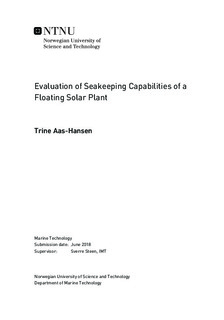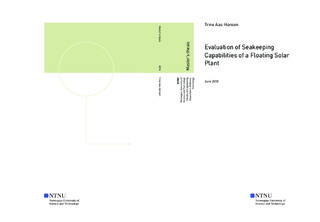| dc.description.abstract | The Norwegian company Ocean Sun has proposed a concept of a floating solar plant as an alternative to conventional land-based installations. This thesis reports the results from a model test on the suggested concept, based on double semi-submerged circular HDPE tubes similar to those of gravity fish cages. In the inner basin of these tori, a membrane is fastened to serve as support for solar panels. Three different model configurations were tested: one without solar panels on the membrane, one with solar panels and one with solar panels rotated 30° relative to the incoming waves, all based on the same floating collar and mooring configuration. The models were tested in both regular and irregular waves with the purpose of investigating the seakeeping capabilities of the suggested installation.
The results presented in this thesis include response amplitudes in the frequency domain, mean mooring loads and visual observations of the model s general behavior in waves with focus on wash, deformations and radiated waves. A thorough presentation of error sources in the experiment is included.
The floating solar plant is flexible and contours long period waves. In shorter waves the floating collar is too stiff to fully follow the wave elevation, and the vertical response decreases. The response plots does not show resonance frequencies within the range of tested waves.
Through visual observations the limiting factor for what waves the structure can withstand is considered to be wash from waves breaking over the structure. Significant amounts of water over-topped the installation in steep waves, which may affect the installation in terms of sloshing loads, corrosion and coverage of panels leading to decreased efficiency.
It is suggested to do a model test dedicated to determining the extreme limits of what weather the installation can withstand, with a focus on modeling the strength of the struc- ture accurately. Furthermore, finding mooring load estimations for a specific area and associated weather condition is recommended. | |

